#1900 Sewing Machine
Explore tagged Tumblr posts
Text
youtube
FC-1900BMP: Bar Tack, Button Sewer and 100 Pattern Sewing Multi Purpose Sewing Machine For Details Call on +91 9811002015
#Bar Tack#Bar Tacking#Button Sewer#Button Sewing#Button Stitching#Button Sewing Machine#Button Stitching Machine#Pattern Sewing Machine#Pattern Stitching Machine#Industrial Sewing Machine#Fucen Sewing Machine#Fucen Industrial Sewing Machine#Bar Tack Sewing Machine#Bartack Sewing Machine#Fucen Bartack Sewing Machine#100 Patterns Stitching Machine#FC-1900BMP#FC-1900BMP Sewing Machine#1900 Sewing Machine#Youtube
1 note
·
View note
Text

#singer sewing machine#wallpaper#lm montgomery#leaskdale#manse#window#1900’s#film photography#personal
61 notes
·
View notes
Text
So awhile back, I posted this thing:
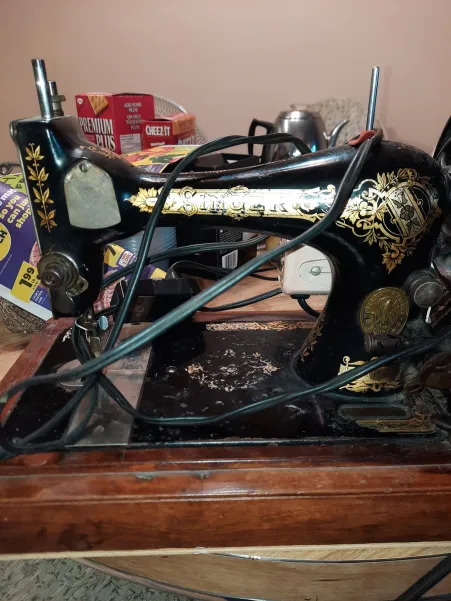
Uh, it turns out this sewing machine is 124 years old, and originally a hand crank model 28-9. I have to clean and replace a bunch of stuff, but very surprising to have such an inheritance that works perfectly fine even in a dirty state-
12 notes
·
View notes
Text

I recently added this lovely Daisy sewing machine from before the nineteen-teens to my collection. She has all of her working parts, and she sews nicely. Welcome home, Daisy!
#sewing machine#antique sewing machine#vintage sewing machine#antique#vintage#crafts#crafting#artists on tumblr#sewing#sewists of tumblr#daisy#1910s#1900s#grandmacore#cottagecore#sewing machines
87 notes
·
View notes
Text



everyone look at the cute dead mid Victorian couple and my new beauty up and running
#the locket is probably gold filled by the luster#Victorian#Victorian era#mid Victorian#the sewing machine is 1930s electric but the table is 1890s-1900s
8 notes
·
View notes
Text

whatever. go my scarab
#frankie.txt#this is my way of announcing I have acquired another antique sewing machine!!!!!!!! eeee lalala#she's a mid-1906 singer treadle so between the two others I have datewise; the cord is from the motor she was retrofitted with in the 70s#I don't have a good picture of the whole machine to share yet because she is in. rough shape#(<- was in the basement of the mother of the landlord of the person who gave it to me for a hot min)#honestly kinda astonished I've managed to get three of these for free. and very very grateful too#I wish this luck upon all my mutuals in their pursuit of antiques 🫡🫡#sewing#singer sewing machine#1900s#1906#go my scarab
4 notes
·
View notes
Text
Kitten I'm going to be honest with you daddy's about to Niccori kori kill themself

#This post brought to you by my absolute exhaustion at sewing#if my fabric puckers inconveniently ONE MORE TIME#I'm going to treat my sewing machine like a 1900s housewife that didn't make me dinner before I got home from work
2 notes
·
View notes
Text
An Incredible Find
This week Delayne used her knowledge of art history to identify a beautiful machine inherited when a beloved local store closed its doors after nearly 100 years. Read "An Incredible Find" to find out more #MarywoodArt #ArtHistory #ArtsAdministration

View On WordPress
#1900s#1920s#Art#art deco#Art History#art nouveau#bridal#embellishments#Geometric#History#International Sewing Machine Collectors&039; Society#Marywood Art Department#Marywood University#Marywood University Art Department#preservation#sewing#Singer Sewing Machine#Sullums#Where Creativity Works
3 notes
·
View notes
Text
First sewing project of 2025 completed!

It's a Vicwardian shirtdress that kind of straddles the lines between historybounding and historical costuming and cosplay.
See, I have made 3-4 blouses/shirtwaists in this style now, and the most irritating thing about them is that they gradually get more and more untucked throughout the day until I'm left with a muffin top spilling over my skirts. So I figured, why not make one that's the bodice of a dress? That way, I can anchor the blouse part down to the waistband so it can't ride up and come untucked, and I can control how much it's allowed to blouse and keep it that way 24/7 since it's stitched down.


^See? Now I won't have to constantly adjust and re-adjust the gathering and pleating into the waistband or tug my shirttails down because I can feel the back of the blouse ballooning out again.
(Almost forgot to mention: yes, the skirt has giant Victorian-style pockets in the side seams. The dress was 99% hand sewn, mostly because I was working on it while out of town without access to my machine, but also because when I got home and tried to attach a facing to the pockets, my machine decided 3 layers of this shirting-weight cotton twill fabric was too much to handle and broke down. So thanks for that, pockets. Now I have to find a repair shop or replacement machine.)
And bonus: the skirt can be worn as is, or it can function as a petticoat under a separate skirt I can wear over the dress. If I make a floor-length walking skirt to wear over this shirtdress, and maybe a waistcoat and/or an Eton jacket, then I'll have a convincing enough 1890s-1900s ensemble for historical costuming purposes.

Oh, and in case you can't tell, the bodice design with the diagonal pintucks in the yoke is inspired by the outfit that Elphaba wears in her "The Wizard and I" sequence from the new movie. She wears this gauzy, crinkle chiffon-looking blouse under a black jumper dress, and the visible parts of the blouse look like they're bias cut, with some kind of pintucked or micro-pleated texture.
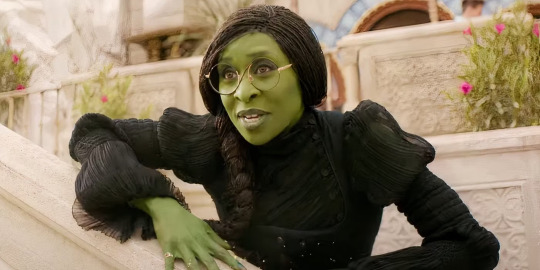
I basically spent the last month and change drooling over the costuming and wanting Elphaba's entire wardrobe. I don't think I'll be accurately recreating any of her actual costumes, but I like to think that my new shirtdress *could* potentially be something she'd wear.

Oh, and here's a detail of the lower sleeves on my dress. Elphaba's usually wearing all black, so the movie costumers played a lot with the texture of the fabrics on her clothing. They were inspired by mushrooms and other earthy textures, so her dresses have a more organic look than what I have going on here. I didn't have enough fabric to play around with, so I figured I'd just give honeycomb smocking a try, and I'm shocked at how well these sleeves preserve body heat in the winter.
Now all I need to do is make her hat and maybe sew a cloth facemask from green fabric and my 2025 office-appropriate Halloween costume will be good to go.
EDIT: link to the pattern I made for this dress here
And here's the dress worn under the corresponding skirt and waistcoat, and Eton jacket.
#sewing#hand sewing#historybounding#historical costuming#cosplay#wicked#tricia sews (kind of)#i'm calling this my first project of 2025 but it's actually my last project of 2024. i just didn't finish in time for the new year
823 notes
·
View notes
Text
Writing Notes: Fashion History

for your next poem/story (pt. 1/2)
1850-1879
The Civil War began in 1861 and ended in 1865, heavily impacting the lives of those living during the time period. In fashion, the rise of the sewing machine allowed more decorative effects to be used in dress, and new aniline dyes paved the way for brighter shades of dress.
This time is known as the Crinoline Period because cage crinoline made of whalebone or steel hoops replaced heavy layers of petticoats, and were commonly worn under dresses by women of the time.
One trend that hit its peak in the 1870s was the bustle, an item women secured under the back portion of their skirts to add volume.
In terms of silhouette, a narrow waist with a fitted bodice and full skirts was the recurrent style. Popular sleeve styles included pagoda sleeves, gathered bishop sleeves, and the coat sleeve.
During the day, high necklines were appropriate, but women often wore lower necklines in the evening.
Wraps and shawls were commonly worn, and accessories such as parasols, gloves, snoods, and bonnets were highly desired.
1870-1900
The years 1870-1900 include what is known as the Bustle period, in which the popular silhouette shifted from full skirts to a more fitted look characterized by fullness in the back.
Throughout the Bustle period of the 1870s and 1880s, a variety of padded devices were utilized to create back fullness, as the bustle took on different forms.
The bustle of the first stage (1870-1878) was achieved through manipulation of drapery and the use of decorative details such as flounces and bows at the back.
From (1878-1883) fullness dropped to below the hips and decorative effects of the skirt became focused low as a result.
Long trains and heavy fabrics also helped to emphasize the focus on the rear.
The latter part of the decade (1884-1890) saw the bustle at its largest. Often referred to as the shelf bustle, it was rigid and took on the appearance of an almost horizontal projection. At this time, skirts shortened to several inches above the floor and rarely had trains, with the exception of some evening dresses.
Additionally, they include the 1890's, which are often referred to as the Gay Nineties or La Belle Epoque. Times were good, Paris was the center of high fashion, and for those who could afford it, dress was lavish and highly decorative.
The corset continued to be worn, aligning with the fashionable silhouette of a full bust and hips with a narrow waist.
Dress ensembles typically consisted of two pieces -- a bodice and matching skirt.
The one-piece princess dress, worn by some during the latter part of the period, was an exception. Bodices were often fitted, with the cuirass bodice style emerging from around 1878-1883.
Sleeves were close-fitting and ended at either three quarters or at the wrist.
Evening dresses were differentiated by their lavish trimmings, level of ornamentation, trained skirts, and short sleeves. Weighted silk offered greater body and was a popular choice for dresses beginning in the 1870s.
Full sleeves were at their largest in 1895, before they gradually decreased in size towards the turn of the century.
By the 1890s, sleeve with fullness were only seen with small puffs at the shoulders.
Tailor-made costumes consisted of wool or serge skirts worn with a shirtwaist blouse. and were considered ideal for traveling.
Shirtwaist blouses were often accessorized by cravats and jabots. The variety of outerwear for women increased during the late nineteenth century and was dominated by coats, jackets, and wraps.
Accessories of the period included small hats, gloves, muffs, decorative fans, and parasols.
1900s
The first decade of the twentieth century is often referred to as “La Belle Époque” - French for "the beautiful age." During this time, Paris reigned as the capital of art and fashion, extravagance and opulence was in, and French couture became all the rage.
Edward VII became King of England with the death of Queen Victoria in 1901, ushering in the “Edwardian Era.”
Additionally, Henry Ford's Model-T was introduced in 1908.
Art Nouveau influenced fashion and ornamentation with the popularity of curvy shapes, floral prints, and ornamentation.
And with the introduction of Ford's Model-T, "motoring garments", such as duster coats and goggles, became essential for automobile riding.
The dominant silhouette of the period was the S-bend hourglass shape, which was achieved through the use of long bell or trumpet skirts that swept the ground, and the “monobosom” fullness of the front bodice.
Voluminous sleeves were another popular feature of turn-of-the-century fashion. Women still wore tightly-boned corsets, along with layers of petticoats. Two-piece ensembles were introduced, consisting of a skirt and a shirtwaist blouse. Garments often featured necklines with high standing collars for daytime and exceptionally low décolleté necklines for evening wear.
Lingerie dresses — flowing white gowns with lace detailing — were a popular choice for outdoor hot weather. Pale colors and un-patterned fabrics adorned with lace or embroidery were favored in this style. Shoes and boots exhibited pointed toes, and parasols were a must-have accessory for outdoors. Elaborate, often large hats decorated with bird feathers enjoyed heightened popularity.
1910s
The War Years (1914-1918) resulted in simpler styles, with moderation in fabric usage as well as the use of darker hues. As a result, garments of this period often have a more utilitarian and masculine appearence.
The “teens,” as the 1910s are often referred to, saw sweeping changes in fashion due to the work of French designer Paul Poiret, who was largely inspired by both the exoticism and color of the Far East and the Ballet Russes. “Orientalism” in fashion became all the rage and was seen in kimono-shaped coats, capes, saturated colors, and exotic embellishments.
Popular trends included the “peg-top” silhouette with hip fullness, Paul Poiret’s narrow-at-ankle “hobble skirt”, and Mariano Fortuny’s “Delphos gown” which featured his secret pleating technique.
Tunic dresses were also introduced, and featured a short skirt layered over a longer one. Necessitated by the new shapes in fashion, the hourglass S-bend silhouette transitioned into a more column-like, tubular form with a higher waistline. Brassieres replaced tight corsets and accommodated the soft, unfitted tea gown, a popular choice for afternoon hosting. The wide-brim hat continued to be a fashionable accessory and shoes began to replace boots.
1920s
The year 1920 marked the beginning of Prohibition, as well as the end of the Suffrage Movement, with women gaining the right to vote.
King Tutankhamen’s tomb was discovered in 1922, further fueling the taste for the exotic, and creating an obsession with all things Egyptian.
The Harlem Renaissance ushered in the Jazz Age; sleeveless dresses with shorter hemlines and sequin, bead, and fringe embellishment enhanced and enabled the fast-paced dance movements of the Charleston and Fox Trot.
The "Roaring Twenties" were years of major change for both fashion and society.
Besides major cultural events inspiring change, fashion was also influenced by Art Deco through the use of straight lines and geometric forms in both silhouette and decoration. The twenties silhouette was straight and tubular, and dresses deemphasized female curves, breasts, and hips.
Chemise dresses hung straight from the body and helped created this fashionable linear silhouette. The “flapper,” with her bobbed-hair and boyish silhouette, became the epitome of the fashionable look of the period. Hemlines rose, revealing more of the female leg for the first time in dress history, and shifting the focus to shoes for the first time.
During the period, Gabrielle “Coco” Chanel popularized costume jewelry — as well as wool jersey suits.
The cloche, a bell-shaped hat, was “the” hat to have.
Small beaded purses and long beaded necklaces were popular accessories.
1930s
The defining event of the 1930s was the Great Depression.
The stock market crash of 1929 and the ensuing depression created a need for less expensive garments without elaborate ornamentation. Designers of the period therefore relied on seam lines and darts as major forms of embellishment. Clothing that was cheaper and diversified was critical, thus creating the need for ready-to-wear fashion.
The overwhelming popularity of the movies in the 1930s helped perpetuate the ideals of “Hollywood glamour.” Women began looking to screen stars for inspiration in fashion, hairstyles, makeup, and even demeanor. The movies, and the glamorous lifestyle they portrayed, were a way for the public to escape the harsh realities of the Depression.
Designers such as Elsa Schiaparelli incorporated concepts of Surrealist Art into fashion designs, offering fantastical creations that also provided a flight from reality.
The 1930s also saw the birth of American sportswear and two-piece bathing suits for women. The decade saw a continuation of the linear shape of the 1920s, but with a leaner, longer, more feminine silhouette. The waistline returned to its natural position and hemlines dropped. Evening fabrics tended to be pale or white solids of silk or satin, and the backless evening gown was introduced at this time.
French designer Madeleine Vionnet created the “Bias Cut”, which produced a “liquid” clinging effect on the body. Hats of all varieties were widely worn, and a right-angle tilt was a common way hats were styled. Shoes featured low heels and rounded toes. Costume jewelry and fur added the final touch of fashionable glamor.
1940s
World War II began in 1939, ushering in a new conservatism in fashion. Fashion designers were forced to close their houses in Paris, and “practicality” became the new buzzword in fashion, with a focus on producing sensible styles and “utility garments” which required a minimum quantity of fabric.
In the United States, the L-85 Limiting Order aimed to freeze the war-time silhouette and stop rapid seasonal changes in styles in order to conserve fabric use. Tailored suits and military-influenced styles were seen in items such as belts, breast pockets, high necklines, and small collars. Both clothing and hair were influenced by the war.
For women who worked in factories, superfluous decoration and long hair posed safety threats. Hairstyles and makeup became an integral way to achieve personal style, since clothing and accessories were rationed.
Hollywood stars such as Veronica Lake, Rita Hayworth, and Bette Davis were significant influencers of fashion. American designers began developing sportswear collections, spurred by the necessity of the war-time focus on the ideals of simplicity and utility.
Casual separates, shirtwaist dresses, slim skirts with patch pockets, and halter and square necklines became popular. Women could also be seen wearing trousers, although it was mainly for utilitarian purposes, not everyday wear.
The 1940s silhouette was tailored and narrow, with a nipped-in waistline and squared shoulders achieved through the use of shoulder pads. Hemlines rose to just below the knee. In light of rationed fashion, hats allowed an individual fashion statement, and small styles such as veiled pillboxes and berets, often worn at a right angle, were most popular. Shoes were usually chunky with rounded toes and featured either low-heeled or wedge soles.
Leg makeup was also introduced and offered women a remedy to the rationing of nylon stockings.
More Notes: On Fashion ⚜ Writing Notes & References
#writing notes#fashion history#writeblr#worldbuilding#spilled ink#dark academia#writing reference#fashion#literature#writers on tumblr#writing prompt#poetry#poets on tumblr#creative writing#writing inspo#writing inspiration#writing ideas#fiction#writing resources
222 notes
·
View notes
Text
nanea, maryellen and melody's behind the scenes facts! :D

To ensure accuracy, author Kirby Larson worked with an advisory board, including a Hawaiian language professor, hula experts, historians, and Pacific Islanders—such as Dorinda Nicholson, who witnessed the Pearl Harbor attack as a child.
Nanea’s outfits and accessories were inspired by traditional Hawaiian fabrics. Her play outfit features palaka, a checkered cloth originally imported from England and worn by Hawaiian plantation workers in the early 1900s.
Nanea��s luau lei includes hibiscus flowers, which are native to Hawai‘i. The state flower is the yellow hibiscus.
American Girl sought to authentically represent Hawaiian culture by incorporating music, dance, ’ohana (family), and kōkua (helping others) into Nanea’s story.
The street names in Nanea’s story, like Fern Street and Pumehana Avenue, are real, but the house numbers are fictional.
Kirby Larson hoped Nanea’s persistence and courage would inspire readers “to give it one more try and not give up, no matter how rough things may look.”

To ensure authenticity in Maryellen’s story, author Valerie Tripp and researchers read the exact newspapers the Larkins would have received, capturing details like the daily weather at the beach and the latest 1950s news.
Maryellen’s school outfit features a charming “Peter Pan” collar, a playful reference to the novel, stage play, and the Disney film, which was released in 1953.
Valerie Tripp consulted an aeronautics expert to make sure that Maryellen’s flying machine was scientifically accurate.
The Seaside Diner is one of the largest playsets ever made by American Girl, featuring real jukebox sounds and over 30 pieces, including diner menu foods like burgers, shakes, and fries.
The product designers searched antique stores, flea markets, and vintage sewing supplies to find authentic 1950s fabrics for Maryellen’s outfits.
Valerie Tripp drew inspiration for the story from her own experiences growing up in the 1950s.
American Girl wanted to bring the 1950s to life to connect daughters, mothers, and grandmothers, allowing them to share memories and make new discoveries about the era together.
Knowing the books would be a multigenerational shared experience, Valerie Tripp emphasized how women’s roles evolved in the 1950s. She also hoped Maryellen would inspire girls to “stay true to the person you really feel you are.”

To create Melody’s story, author Denise Lewis Patrick consulted with a six-member advisory board of historians and educators who had a rich knowledge of Detroit’s history and the civil rights movement.
Melody’s accessories include a pin that is a miniature replica of the pins worn by marchers at Detroit’s Walk to Freedom.
To create Melody’s recording studio, the American Girl team visited real 1960s recording studios, including Motown.
American Girl chose the year 1964 because it was a time of heightened energy and optimism in the civil rights movement.
All of Melody’s clothing, from her houndstooth dress to her cat-eye sunglasses, is emblematic of the 1960s.
Advisory board member Dr. JoAnn Watson grew up in 1960s Detroit. When she was twelve years old, she marched with her grandparents in the Walk to Freedom.
Melody wears a Breton hat, a style traditionally worn by French agricultural workers that became a global fashion trend in the 1960s.
Denise Lewis Patrick saw Melody’s story as a way to help girls realize their individual power. She says, “Melody helps readers to understand that there is always something they can do to help change their world for the better.”
bonus- family and friends:


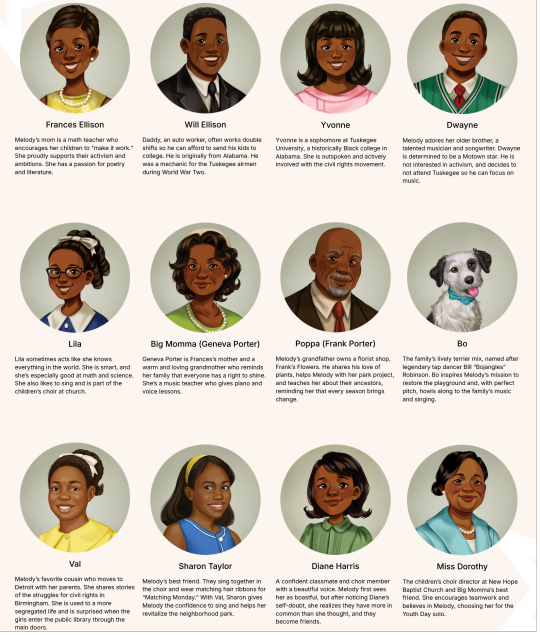
#american girl#american girl doll#nanea mitchell#maryellen larkin#melody ellison#it's weird seeing them in their cartoony diary forms when the others are realistic! :o#same with val and sharon!#but they're so cute! :D
75 notes
·
View notes
Text
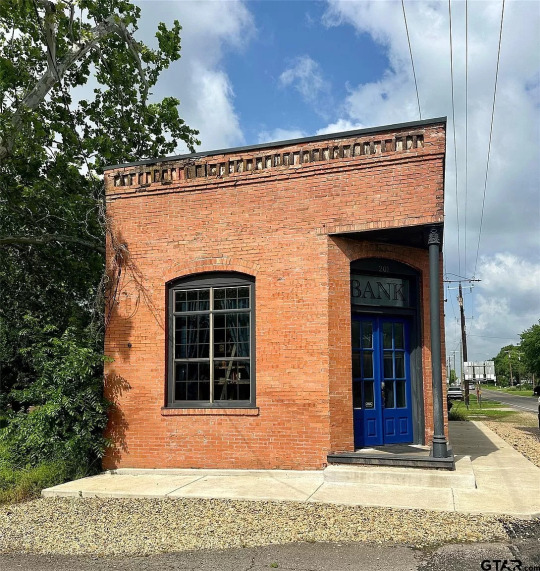
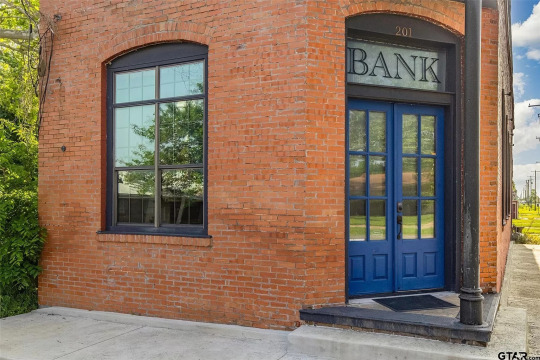
Well, here's a bank conversion finally done right. The bank was built in 1900 in Cumby, TX, (about an hr. from Dallas) has 2bds, 2ba, & is listed for $275K.
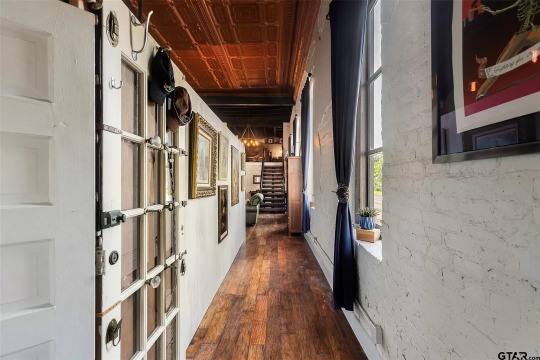
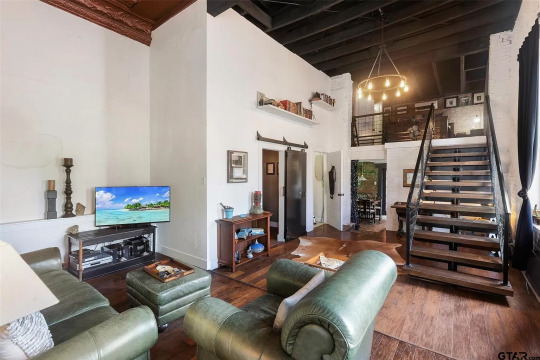
They made a hallway to accommodate a wall to build more rooms. Then down the hall, you come to this lovely open living room.
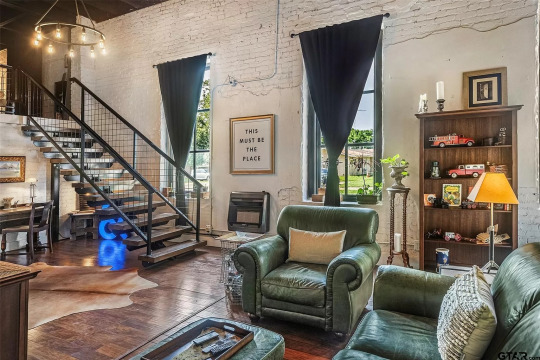
I like the old brick walls. I guess they painted them white to brighten the home.
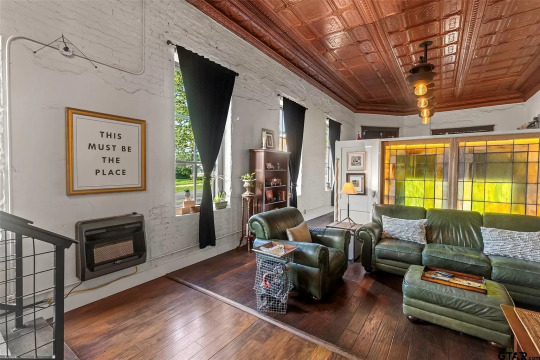
Very nice- the windows look like they could be architectural salvage. Love the ceiling.
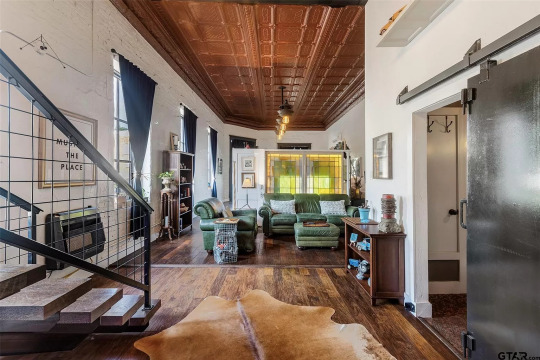
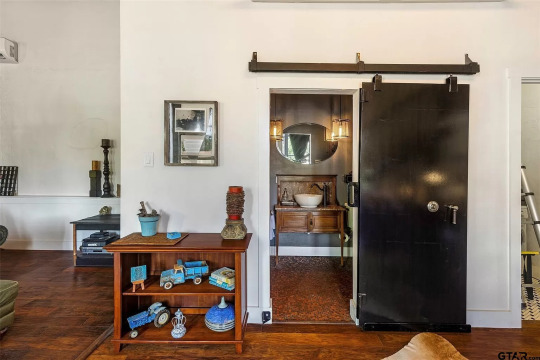
I like the industrial sliding door made out of the original vault door.
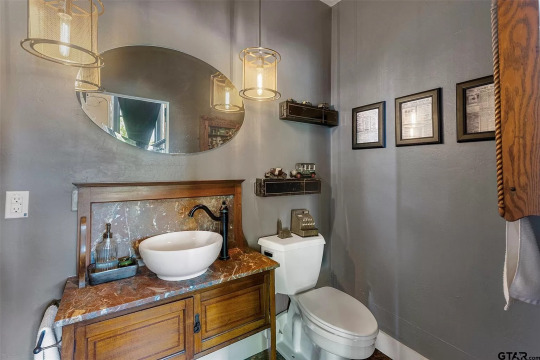
It's possible that this cute vintage bath was the vault.
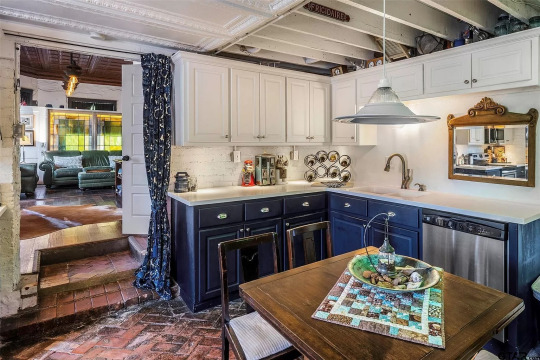
A couple of steps go down to the kitchen. This is adorable.
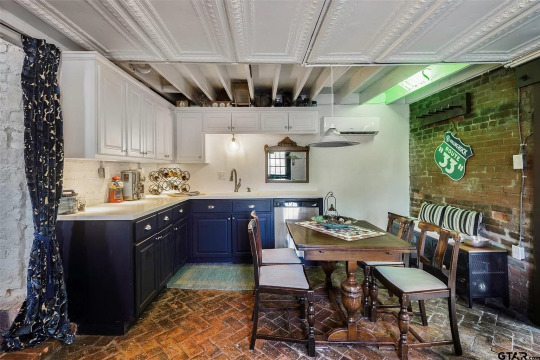
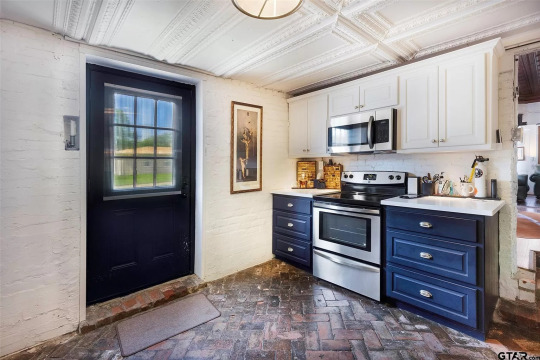
Love th vintage look, blue & white two-tone cabinets, and the exposed brick wall. The kitchen has a door to the outside.
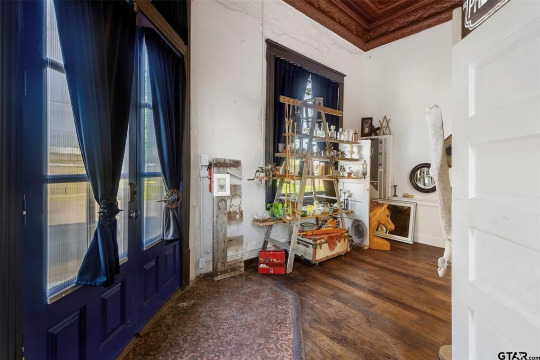
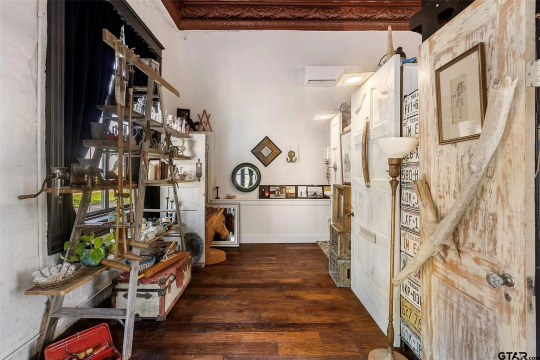
This room would make a great studio or craft space. It could be a man cave or a lady lair, too. Cute flex space.
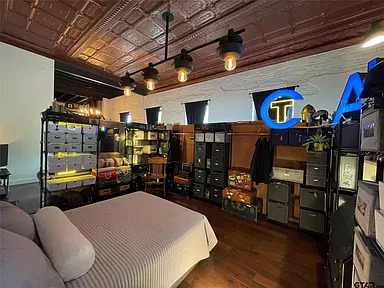
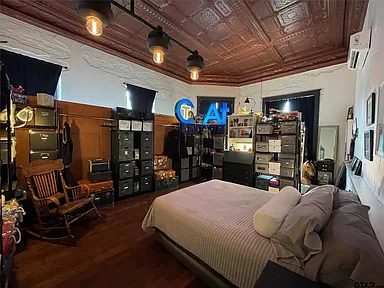
This bedroom is on the other side of the hallway wall.
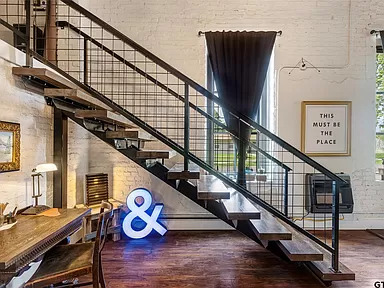
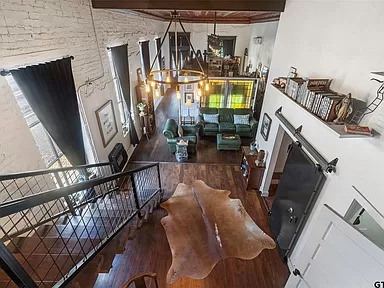
Looking down at first floor.
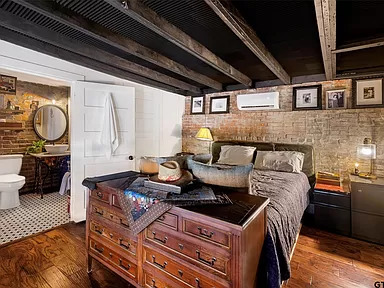
Upstairs is the primary bedroom. Lovely brick wall and beamed ceiling.
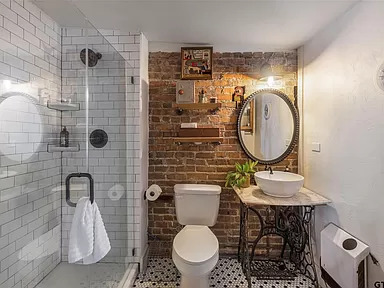
It has a beautiful double shower, vintage tile floor, and a sink made from an antique sewing machine base.
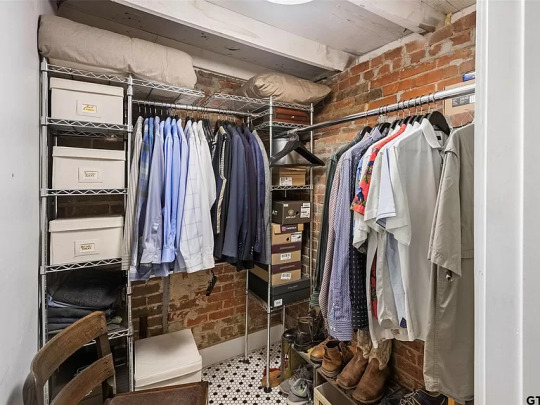
There is also a small walk-in closet.
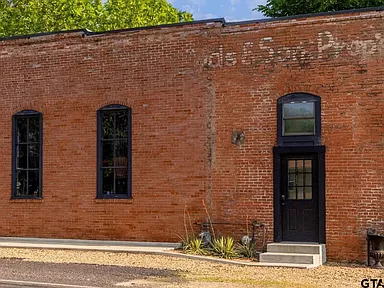
The kitchen door looks like it provides access from the driveway.
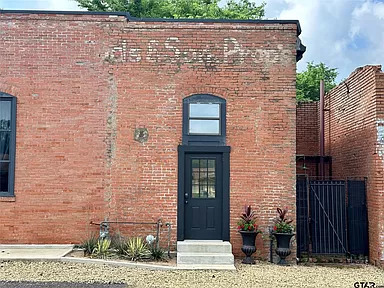
There's a faded sign indicating that there was a business in the building, at one time.

This gate provides privacy.
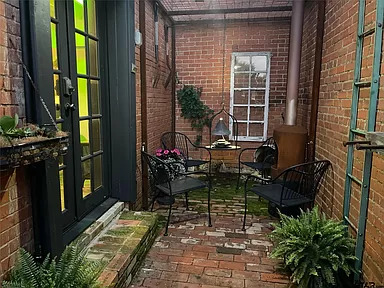
For a small space that makes a great little patio.
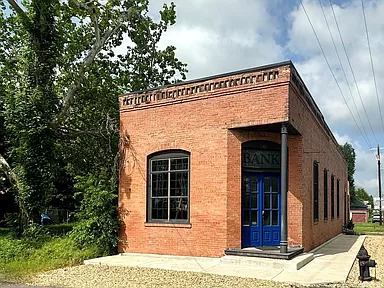
The lot is 1,742 sq ft, so I'm thinking that it must include some of the grassy area along the side.
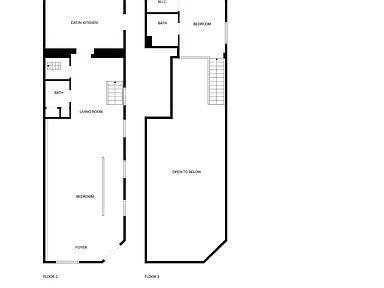
https://www.zillow.com/homedetails/201-W-Main-St-Cumby-TX-75433/243395593_zpid/?
#converted bank#bank conversion#unusual homes#unique homes#houses#house tours#home tour#homes under $300K
333 notes
·
View notes
Text
We went indoor rock climbing with friends, were late dur to work.
So we took a few minutes to check out the new second hand furniture store near the climbing studio.
And I found a new friend!

It's an old treadle sewing machine from a German manufacturer. This model might be from before 1900.
If I squint I Might have the space for her. And if I'm correct she'll be absolutely breathtaking gorgeous!
And only for 75,-€!!
If I'm brave enough I'll go back tomorrow and ask if she's in working condition, and if I'm allowed to test her
There's also a singer, but I didn't look to closely
91 notes
·
View notes
Text
☆Update 2:☆
I remembered to take pics today! Sort of. Only after i had put away my machines and stuff...
Here are (most) of my edwardian undergarments
(i am wearing modern clothes under bcs the internet is weird)
Chemise, bustle pad, underbust corset, petticoat
I still need to make a corset cover someday, ive just been using a second thin chemise over all this:
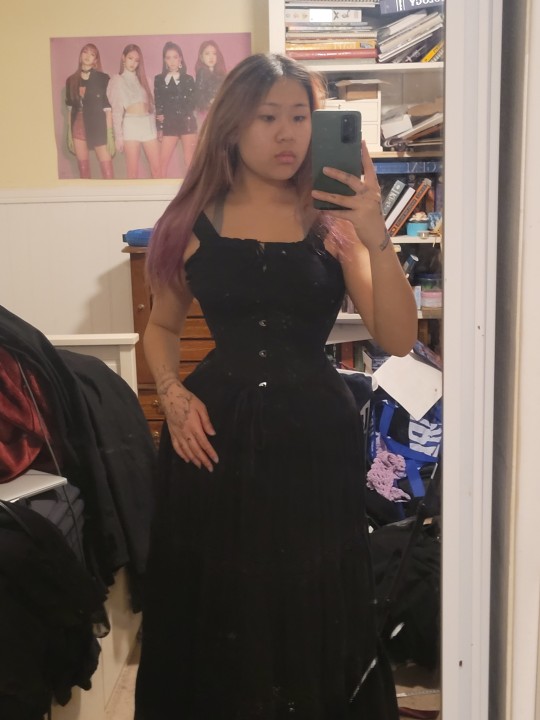
I used these vintage buttons on the cuffs. I wanted some more security but ran out of buttons so i used small snaps:
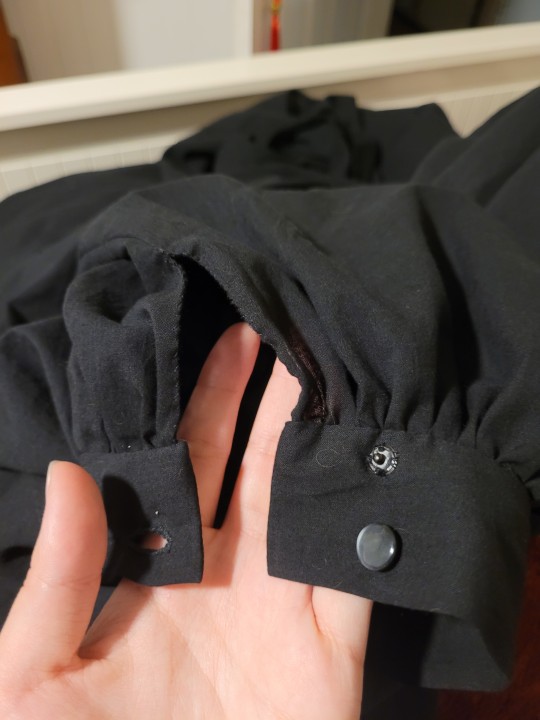
Also put one on the collar so i could try it on. I think the placket at the back of the blouse is a little ugly and larger than ive seen in extant garments but i forgot to adjust the pattern for my broad shoulders and need the extra width for comfort.
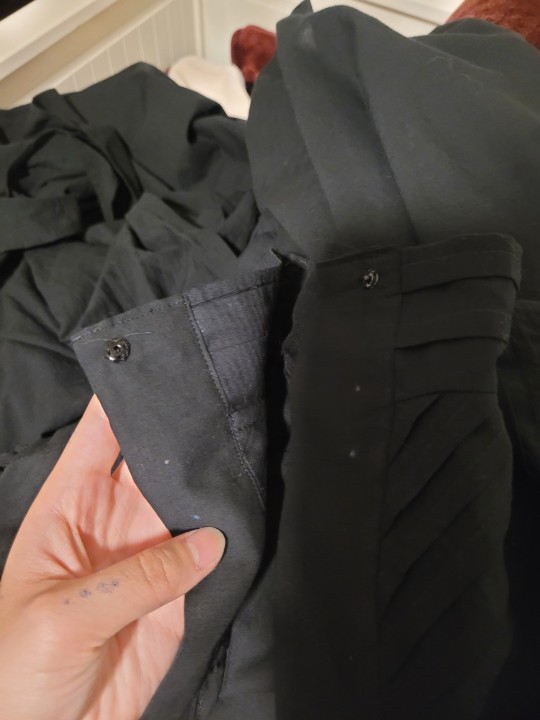
I tried on the blouse and skirt together:
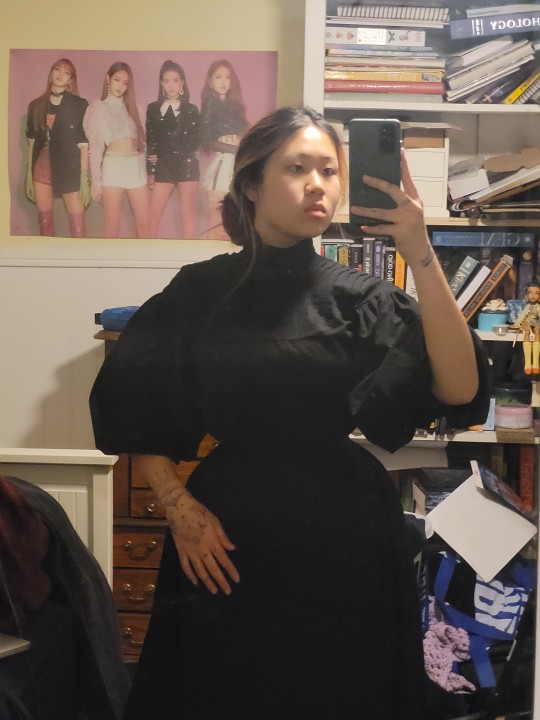
I may need to loosen the waistband of the skirt, the corset is a bit bulkier than i thought itd be. Also the blouse is just stuffed into the skirt and currently only has one closure on at the collar so it looks a little bit disproportionate. The belt/sash will help smooth everything out so i dont look like im drowning in voile.
I might go without the bustle pad during the final shoot because i think it gives too much volume in the waist/hip area for edwardian tastes. Its from an 1890s pattern, so the silhouette is a bit out of date. I should probably try the skirt on without the pad before extending the waistband though.
Im pretty happy with how the sleeves turned out! I have some vintage nottingham lace i bought on etsy from penelope textiles that i was going to add to another project. I think ill sew some different laces together and add it to the cuffs to elongate them a bit. Since this dress is supposed to be from roughly 1905, i want the sleeves to look as they wouldve in that time. The photos ive seen mostly feature large ruffles at the ends of elbow-length sleeves but i dont think ill be likely to wear ruffles very often. Ive also seen tighter cuffs that extend from the elbow to mid-forearm or from the elbow to wrist. I think the elbow-length sleeves are a feature of afternoon dresses but i could be wrong. Maybe that was just day dresses? Not sure.
Im also not sure if i want to get gloves/a hat/parasol for this project. On one hand, it would look really cool for the video. On the other hand, it sounds quite expensive and i doubt ill wear it again. I dont want to buy things i wont use and create waste, theres enough of that in fashion. I have a pink 1900s parasol that i might cover with black fabric, but idk.
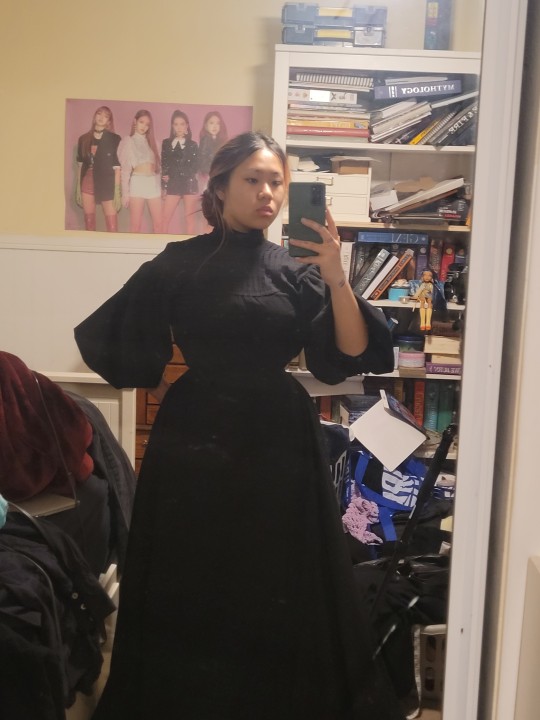
There isnt much left to do! Im gonna make a list here so i have it written somewhere:
-sew snaps onto blouse
-finish blouse hem
-attatch lace cuffs
-press pleats on sash/belt
-order synthetic whalebones
-add bones, hook/bars to belt
This is just the sewing tasks though, i need to edit the video clips and record audio. I have no idea how to do any of this. I just downloaded davinci video editor so hopefully i can figure it out. The only experience i have with video making/editing was in 3rd grade on ipads on the imovie app. Ive just been binge watching bernadette banner videos bcs i love her video style.
Any tips/feedback are much appreciated! ♡
Date: 4/22/24
#edwardian fashion#1900s#early 1900s#edwardian era#edwardian#victorian mourning#victorian dress#victorian era#victorian fashion#fashion history#historical costuming#historical dress#historical fashion
102 notes
·
View notes
Text

Trade Card for Wheeler & Wilson's New High-Arm Family Sewing Machine ca 1900
18 notes
·
View notes
Text
I went to a local (!) bindery museum today. Mostly 1900s industrial scale machinery- you know, not for a modern business and Certainly not for a hobby-binder- but that's what made it charming. Just fascinating machines for all your horseshit needs. An industrial shoulder curvature machine! A Goddamned Beautiful and Extremely Dangerous Spine Rounder! Two seconds, perfect curve. Wild. Just wild. Greatly covetous of the signature sewing machine.
Good shit.
18 notes
·
View notes